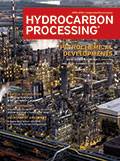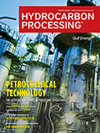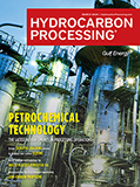
April 2016
Special Report: Petrochemical Developments
The existing petrochemical value chains in Qatar are analyzed in this article to identify the potential downstream industry opportunities.
Contemporary routes to the production of polymers usually involve setting up world-scale ethylene crackers with typical capacities of 0.7 MMtpy–1.5 MMtpy.
HPI Focus: Iran Petrochemicals
The recent agreement between Iran and the international community represents clear opportunities and challenges for petrochemical producers.
Environment and Safety
The function of a flare system in a refinery or chemical plant is to collect gases released during an overpressure scenario, typically resulting from a plant upset.
Heat Transfer
The fractionation tower/column is common processing equipment in the petroleum refinery and chemical industry.
Process Engineering and Optimization
Visbreaking technology is a well-known, simple thermal cracking process for residual oils.
Despite the challenges that major projects can present (short deadlines, budget constraints and overruns, unforeseen problems onsite and tension throughout executive teams), they can also prove to be a win-win for both the owner and the engineering, procurement and construction (EPC) firm.
Rotating Equipment
In most process plants, it is unusual to install a pressure safety valve (PSV) to centrifugal pump and compressor discharge, but some PSVs are needed and are installed to protect the system against miscellaneous scenarios that could create overpressure in the system.
Columns
Over the past several years, the world has witnessed the announcement of a massive amount of new petrochemical capacity.
ODR, which stands for operator-driven reliability, has recently morphed into a new arrangement of letters: OPPM.
This article is the first under the Codes and Standards series. The purpose of this series is to make readers aware of code requirements, the interpretations and the limitations as they stand today, and what engineers can do as an alternative engineering. This series is based on the actual implementation of what is narrated and the satisfactory experiences drawn.
To survive and stay competitive in the rapidly changing, technology-driven hydrocarbon processing and petrochemical fields, companies must stay ahead of their research and development (R&D) needs.
The next generation of manufacturing will be driven by connectivity. It is happening today in modern plants: the Industrial Internet of Things (IIoT) is enabling manufacturers to embed physical objects with the capacity to both communicate with and sense the world around them.
Trends and Resources
When Ali bin Ibrahim Al-Naimi agreed to speak at IHS CERAWeek in February, the expectation was for the Saudi oil minister to defend his country’s energy policies, possibly creating a regional divide at the annual Houston conference.
This series examines the global petrochemical landscape, new project developments and regional outlooks.
US product markets weakened despite strong domestic gasoline demand.
This month’s installment of Global Project Data focuses on the global petrochemical sector.
PKN Orlen seeks refinery energy efficiency solutionPKN Orlen has selected six solutions best designed to improve a refinery's energy efficiency.
Marathon Petroleum Corp. has named Gary Heminger, the company's president and CEO, to succeed Thomas Usher as chairman of the board, in addition to his current duties.

- WestJet buys first Canadian-supplied SAF by Shell Aviation 4/23
- Technip Energies selected by Viridor to perform FEED on the Runcorn energy-from-waste carbon capture project in the UK 4/23
- SINOPEC completes its involvement in Kazakhstan's polyethylene project 4/23
- Neste premieres at Chinaplas: showcasing possibilities of bio-based and recycled materials for plastics 4/23
- Russia's oil refining near 11-month low 4/23
- Haiti fuel terminal operations halted as gangs seize trucks 4/23




